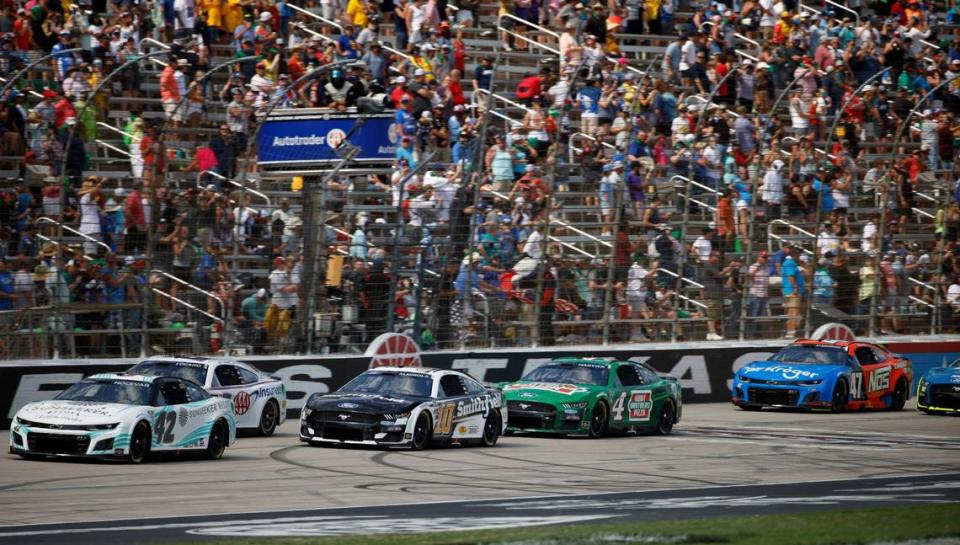Reality of NASCAR’s future both in Texas, and all over the United States, is the same

Unlike O.J. Simpson, the pending funeral service for NASCAR has been widely exaggerated. (Sorry, but who can resist?)
NASCAR ain’t dead, but the most popular auto racing league in America has settled into its points of origin, not a grave plot. NASCAR is, and will forever remain a moonshine-runner’s sport, born in the Southeast, with a “smaller” audience compared to other sports.
It was never the NFL 2.0 that it thought it became in the late ‘90s when the circuit continually expanded, and tracks were built from Fort Worth to Iowa.
The same can be said of NASCAR. What is the long term future of NASCAR both in the U.S., and here in Texas? It’s “fine.” “Fine” is one of those flexible words that can imply irritation, disgust, doom, to good. In this case, lean hard towards the latter.
For those Texans familiar with the opening of Texas Motor Speedway in north Fort Worth, in 1997, it is hard to believe that the mighty track is now a one-race facility here in 2024. At least for this year, TMS will host one major race; NASCAR’s AutoTrader EchoPark Automotive 400 on Sunday at 2 p.m. is it.
Much like the surrounding neighborhood around TMS, it’s all just so much different now.
“There was one gas station here on the corner; that was it,” said Prosper native, NASCAR driver Chris Buescher of the development around TMS since he came here as a young kid to watch the races. Buescher was in town last month to promote the upcoming race at TMS.
“None of this (sprawling commercial development) across the street. That was a big field,” he said. “There was nothing out here. It’s wildly different than what I remember. There is so much growth, it’s so strange. It’s strange to see it all so different, but it’s neat, too.”
Track officials are optimistic that the IndyCar series will return to TMS in 2025. As far as the days of NASCAR running two races at TMS, those are over for the foreseeable future.
Like so many businesses, NASCAR fell victim to over-expanding and over-saturating the market with its product; now it deals with the consequences of those decisions that were all made for a different time of sports’ consumerism.
We are a stimulated-craved culture. Whether it’s Formula One, IndyCar, or NASCAR, an auto race can offer spectacular sequences, followed by prolonged periods of subtle drama, and monotony.
“On the surface, people would joke about the simplicity of going in circles, right? Buescher said.
Yes. Four left turns for two hours is simple.
“It’s never that simple,” he said. “I’d make jokes about different sports because I didn’t have the full inner workings of how it went, but I took a few simple tours of the Cowboys training facility 10 years ago. To me, I didn’t understand football because I was racing so much.
“It seems simple on the surface until I got to see what goes into every game, every week. If you get into the inner workings of (NASCAR) you can appreciate it more and more, and how neat and creative you have to be.”
NASCAR’s challenge is to get people to care about those specifics.
NASCAR has shotgunned a flood of darts at the board room wall in hopes of growing its an audience. The Clash at L.A. Coliseum is a great TV visual, the same for the road race in downtown Chicago. Returning to the old track at North Wilkesboro, North Carolina offers a vintage look.
Tracks aside, this comes down to people and personalities.
The challenge is a sports league, or network, can’t just ask AI to build one. These creations happen organically.
After decades of trying, F1 finally found an American audience through its globally popular “Drive to Survive” series on Netflix. The surge from that show has faded, but F1 now has a foot in the United States’ market.
An F1 race isn’t that exciting, but people know Lewis Hamilton, Max Verstappen, Sergio Perez and a few others. It has audience because people care about the particulars beyond just a turn or two.
Belatedly, NASCAR tried the same formula with its “Full Speed” on Netflix. It’s well produced. Much of it is compelling.
The challenge for NASCAR, or any entertainment company, is to be the priority in a market that is flooded with distractions, and quality programming.
NASCAR has its place. And it’s not a grave plot.

